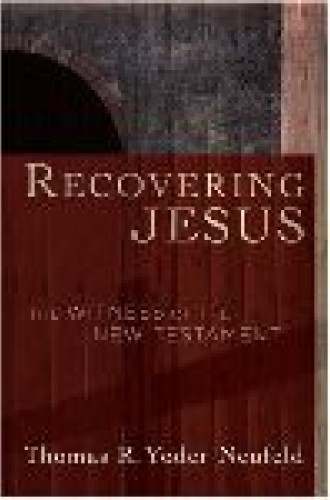Recovering Jesus: The Witness of the New Testament
My first impression of Thomas R. Yoder Neufeld’s study was that it tries to be three books in one without succeeding as any of the three, but I discovered that this apparent weakness of the book is also its greatest strength. On the surface, Recovering Jesus is a survey of recent studies constituting the so-called third quest for the historical Jesus, but it does not focus exclusively on Jesus because Jesus studies raise questions about the Gospels as sources for the quest. So Yoder Neufeld has also written an introduction to the synoptic Gospels. Finally, he has decided to pepper his study with other portions of the New Testament in the style of an introduction to New Testament theology—or New Testament Christology, if you prefer. Three books in one!
Because of this structure, the book can be confusing. For example, Yoder Neufeld devotes a full chapter to the study of the nativity narratives in Matthew and Luke, and this in turn leads to a string of discussions raised by the material. Does Yoder Neufeld intend this discussion to yield information about Jesus’ birth, or is it an examination of the beliefs held by Matthew’s and Luke’s communities? He can certainly address these issues in his reconstruction, but he needs to be clear about his reasons for doing so and the results that flow from his decision. Having carefully dealt with the layers of Jesus traditions by separating them from the canonical text of the Gospels, he runs the risk of conflating the levels of tradition and confusing his readers.
The heart of the study is a five-chapter section on the kingdom of God. Here is where the book’s weakness begins to evolve into a strength. The choice of the kingdom of God as an integrating theme seems obvious and mundane in light of the seemingly endless ways of examining the historical Jesus—as sage, noneschatological teacher of subversive wisdom, millenarian prophet, pedagogue of the oppressed, teacher of the conventional wisdom of peasants and villagers, parabler and proclaimer of good news, healer, exorcist, one who renews village life through a social revolution. The list could go on and on. Each view catches a glimpse of the historical Jesus but misses the whole picture.
Yoder Neufeld’s approach brings clarity because he uses the unified framework of the canonical Gospels as his guide, and in the synoptic Gospels the kingdom of God is certainly a unifying theme. But he misses or treats marginally some of the more radical readings of Jesus and his concern for justice; every hermeneutical move exacts a price. This mixed result is most evident in the chapter on the parables in which Jesus teaches the theology of the kingdom. Yoder Neufeld’s discussion misses the exhilarating diversity that marks so many recent discussions of the parables, but it does present this unifying vision of the kingdom as the parables’ subject.
It is possible to see the conflicting tendencies at work in Yoder Neufeld’s treatment of the parable of the “day laborers” in the vineyard (Matt. 20:1-16). By designating the workers as day laborers, Yoder Neufeld is signaling an awareness that the social scene depicted in the parable is a moment of oppression and exploitation in which an elite land owner crushes the dissent spoken by one of the laborers. But he also notes that the parable can be read as an example of the scandalous generosity of God. The question with which he closes his discussion hints that the subversive reading of the parable might have some merit. After all is said and done, however, the parable remains ambiguous and still fits into the framework of the kingdom of God. Its prophetic critique of exploitation is muted by this unifying theological framework.
As a three-books-in-one introduction to the historical Jesus, the Gospels and New Testament Christology, Recovering Jesus succeeds admirably and leaves its readers with a clear path through some difficult and debated issues. The references for further reading and lists of key terms and concepts that conclude each chapter make the book especially valuable for readers new to these issues.





